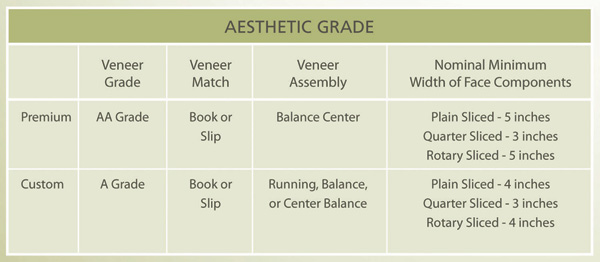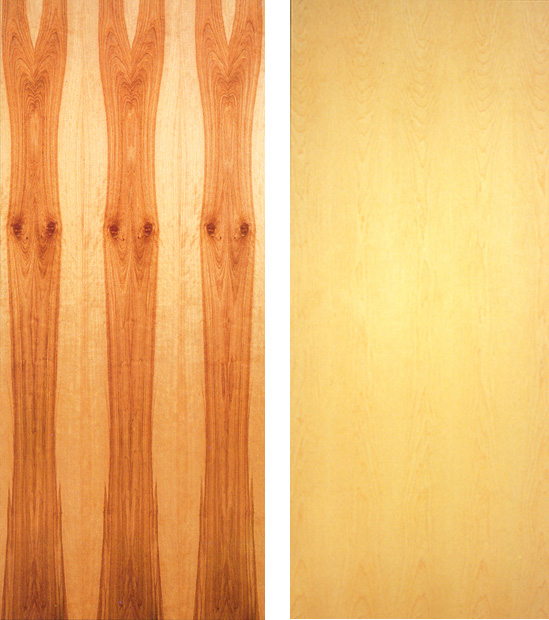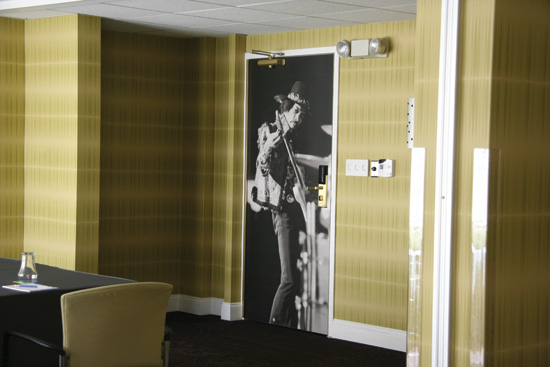Doorway to Distinctive Design
Both WMDA and AWS set two aesthetic grades for architectural wood doors: custom and premium. The custom grade provides a well-defined degree of control over the workmanship, materials, and installation of a project, and is typically specified for and adequately covers most high-quality interior architectural woodwork. Premium grade is reserved for special projects or featured areas within a project. Premium doors are specified when the highest degree of control is required. The difference between the two grades, custom and premium, is the veneer grade, adopted from panel and veneer grading tables established by the Hardwood Plywood and Veneer Association (HPVA), which is an ANSI-accredited standards developer, and from veneer assembly. The accompanying table (see article online) provides a quick reference. In both WDMA and AWS, Grade A face veneer is standard, with WDMA also stipulating book match and running match as standard. It should be noted that AA grade veneer also requires wider minimums for face components with plain sliced and rotary sliced flitches. Naturally, premium doors have a higher cost, and availability may be limited because of the AA grade veneer, center balance, and wider flitch requirements. Further, it is necessary to understand that if an aesthetic grade is not specified, custom grade is the default grade to be furnished. There is no difference in performance duty requirements for custom and premium doors.

Species
While there are many species of wood veneer available, ranging from domestic to exotics, common door veneer species are generally considered to be birch, maple, oak, cherry, and African mahogany.
To ascertain the differences among species, it is important to understand sapwood and heartwood. Sapwood is the living, outermost portion of the branch, and heartwood is the center, mature portion of the tree, which makes up most of the cross section of a log. Generally, sapwood is a lighter color than heartwood. Certain wood species, particularly natural maple and birch, can vary widely in color range, which is why in many cases “select white” is specified so that the sapwood can be accumulated and spliced together to create a consistent color. When specifying “natural” maple and birch, the veneer will contain unlimited amounts of the lighter colored sapwood and/or the darker heartwood unselected for color as well as color streaks, spots, and color variation from almost white to very dark. If a light-colored veneer is preferred, architects should specify all-sapwood maple or birch. If a dark-colored veneer is preferred, specify all heartwood. Veneers, such as maple and birch, may contain sapwood/ heartwood combinations.
Each species has its own inherent characteristics. Red oak, for example, has a coarse, open grain pattern and is more uniform in color with less flake than white oak. By contrast, maple is known for its straight, moderately close grain pattern; it contains both heartwood and sapwood. Birch has a close grain pattern and, like maple, contains heartwood and sapwood. Cherry has a light reddish-brown color and a straight, satiny grain, and mahogany offers a distinct, pleasing grain pattern and has light pink to reddish and tannish-brown colors.
Natural Variation
Wood is a product of nature and, as such, can enhance a project design and aesthetic goals when used in its purest or natural state. However, each wood species will vary in color and grain from tree to tree, or even within the same tree. Environmental factors, such as climate and soil content, can cause each veneer species to exhibit a range of colors and textures. In addition, each wood species has its own particular and industry-acceptable characteristics, and it is precisely these naturally occurring variations that provide such richness and uniqueness to each project. Light and oxidation also contribute effects and can change a face veneer color.

Image courtesy of VT Industries, Inc.
The accompanying image showcases differences between a select white veneer vs. a natural veneer.
Finish Options
Architects can usually consult factory finish samples to confirm the basic color, grain fill, and gloss level of the various finish systems. Most manufacturers also offer a custom finish—providing a small swatch of the desired finish color is typically all that is needed for a quality manufacturer to provide custom matching services.
Factory Finish—Controlled Conditions
The factory conditions of a manufacturer can make a difference in the quality of a finished veneer door. A clean, well-lit plant with automated sanding and staining functions stands in sharp contrast to poor jobsite conditions in the field where dust, poor lighting, and hand sanding and staining may potentially lead to inconsistency in the finish and unacceptable overall results.
That is not to say, however, that all manufacturing plants are created equal. These advanced capabilities enable manufacturers to produce consistent and durable results. In state-of-the-art facilities, doors with veneer faces are first sanded using coarse sand paper, followed by fine sand paper to remove any raised wood fibers. The finish process begins when a water-based stain coat is rolled and brushed into the veneer and dried under heat. Brushing the stain ensures the stain penetrates the veneer grain; this is important for veneers with open grains. Multiple sealer coats are applied next, sealing the stain and achieving the desired gloss to the finish. The seal coats are now finely sanded to remove any wood fibers that may have raised. Finally, top coats are applied and UV treated, ensuring a hardened finish that cures and encapsulates any VOC emissions.










